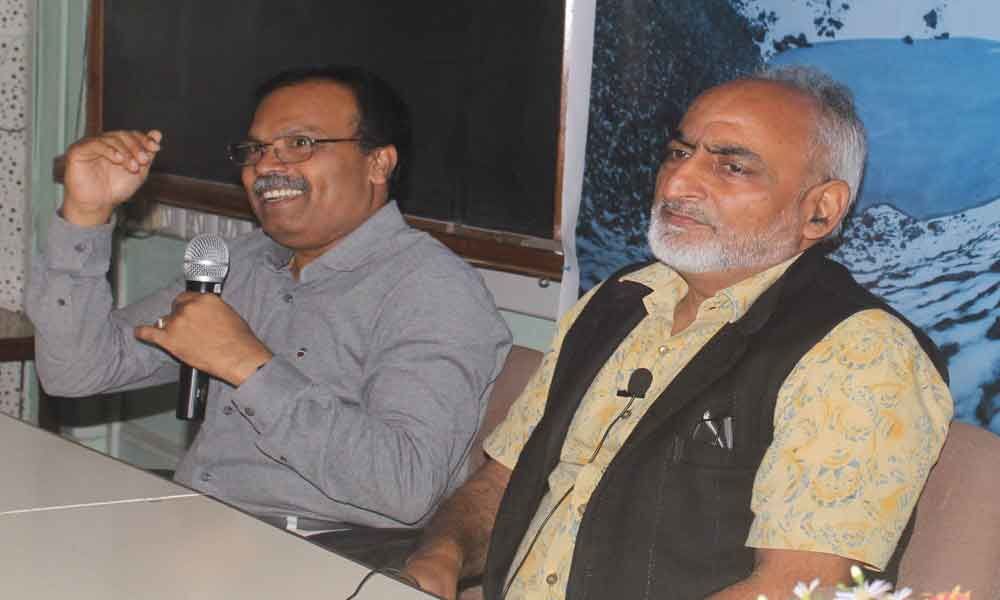Live
- Traffic jam at ghat road as devotees throng Srisailam temple
- NDA govt neglecting edu sector, flays Jagan
- No country in world matches India's zeal for knowledge: Yogi
- Special trains for Ayyappa devotees
- Didn’t expect win margin to be so huge: BJP’s Ramveer
- Am I Pregnant? Symptoms to look out for
- iOS 19 and LLM Siri Delayed Until April 2026: What to Expect
- NGO brings hearing impaired youth into professional path
- Mass Kolatam at SVU enters Wonder Book of Records
- Koil Alwar Thirumanjanam on Nov 26
Just In
Centre for Cellular and Molecular Biology study throws new light on Roopkund Lake


The Centre for Cellular and Molecular Biology (CCMB) has unveiled a decade-long study of the Roopkund Lake, which has been a long puzzle over the years. The lake is situated 5,000 meters above sea-level in the Himalayan mountains.
Habsiguda: The Centre for Cellular and Molecular Biology (CCMB) has unveiled a decade-long study of the Roopkund Lake, which has been a long puzzle over the years. The lake is situated 5,000 meters above sea-level in the Himalayan mountains.
The skeletal remains of several hundred ancient humans, scattered in and around the lake's shores earned it the nickname Skeleton Lake. Ancient DNA obtained from the skeletons of Roopkund Lake, representing the first ancient DNA ever reported from India.
The identity of these skeletons has long been a subject of speculations. Local folklore describes a pilgrimage to the nearby shrine of the mountain goddess, Nanda Devi, undertaken by a king and queen and cont.
their many attendants who were stuck down by the wrath of Nanda Devi due to their inappropriate celebratory behavior. It has also been suggested that these are the remains of an army group of merchants who were caught in a storm also another view is that they were the victims of an epidemic.
Addressing the media, Dr Kumarasamy Thangaraj, co-senior author and chief scientist at CCMB, said, "We first became aware of the presence of multiple distinct groups at Roopkund after sequencing the mitochondria DNA of 72 skeletons (23 males 15 females) were brought from the Lake.
While many of the individuals' possessed genetic information typical of the present-day Indian population, we also identified a large number of individuals with a genetic makeup that would be more typical of populations from West Eurasia." He initiated the work more than a decade ago, in an Ancient DNA clean lab at CCMB.
Dr Rakesh Mishra, Director, CCMB said, "This study highlights the power of genomics study, coupled with other bimolecular tools, in understanding our past and this study would pave a way for analyzing a large number of skeletal remains, obtained from different parts of the country."
The samples brought from the lake was sub-divided into three groups the first group is composed of 23 individuals with ancestries that are related to people from present-day India, who do not appear to belong to a single population, but instead derived from many different groups.
However, the second large group is made up of 14 individuals with ancestry that is most closely related to people who live in the eastern Mediterranean, especially present-day Crete and Greece. A third individual has ancestry that is more typical of that found in Southern Asia.
The study finds out that the two major genetic groups were of approximately 1,000 years apart. The individuals with the Indian-related ancestry died at Roopkund during 7-10th century CE.
The other two groups, likely composed of travelers from the eastern Mediterranean and South Asia, arrived at Roopkund Lake during 17-20th centuries. The study raises a striking question of how migrants from the eastern Mediterranean died there a hundred years ago.

© 2024 Hyderabad Media House Limited/The Hans India. All rights reserved. Powered by hocalwire.com






